The Bridges that are listed are as follows:- Barnes, Battersea, Blackfriars, Hammersmith, Hungerford, Kew, Kingston, Lambeth, London Bridge, Putney, Richmond, Southwark, Tower, Vauxhall, Victoria Bridge (Chelsea), Wandsworth, Westminster.
Blackfriars Bridge- Infamous in modern times for being the bridge under which the body of Roberto Calvi was found hanging. He was a former Chairman of Italy’s largest private bank and was discovered with some bricks and thousands of dollars stuffed in his pocket in June of 1982.
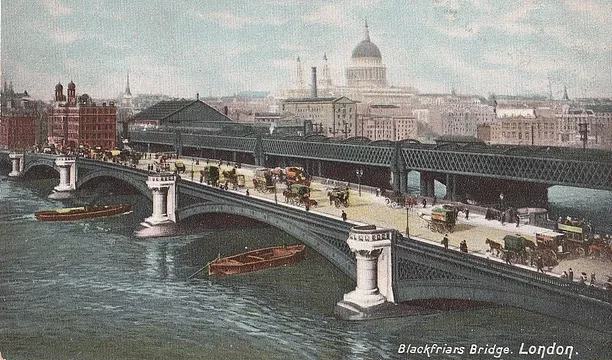
1/ Blackfriars Bridge Child Murder, April 1867
The clearly insane Mary Ann Hathaway aged forty-five and married was up in court on the charge of wilful murder of her daughter, Mary Hathaway. Her behaviour of late had been very strange and was passed off by friends and family, as she had been in a lunatic asylum, twice before. She walked over Blackfriars Bridge and simply tossed the child over the parapet, thinking she would hear a splash as it entered the Thames, instead heard a dull thud as the poor little mite landed on a barge, then died of its injuries.
2/ Blackfriars Bridge, (Headless Corpse) January 1902
The lower portion of a female was discovered in the Thames near to Blackfriars Bridge. The limbs were nude, apart from the pair of stockings, which puts pay to the suicide theory. A post-mortem examination showed that the limbs had been in the water for a long time, and due to the decomposition it was hard to say if they had been chopped from the upper part of the body, or caught in the propellers of riverside barges. (Was she ever identified?)
3/ Blackfriars Bridge, November 1907 (Four Men Killed)
This tragic accident happened while the four men were working on the bridge-widening scheme, that was going to take up to three years to complete. A giant support collapsed when being lowered into the Thames, to form one of the foundations for the widening of the bridge. It weighed around 200-300 ton and it toppled into the river, taking the men with it. Patrick Irvine aged forty-seven and from Glasgow,~William Grant age thirty-seven, from Aberdeen and William Foster and Arthur Cousins, were the men killed. Grant and Irvine got tangled in the wreckage and went down with it, and Foster and Cousins were mangled in the steelwork.
4/ Blackfriars Bridge Suicide Rescue, January 1899
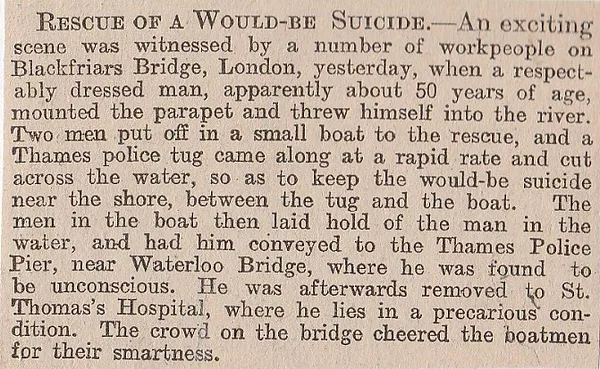
5/ Blackfriars Bridge, January 1891 (Suicide Note)
57-year-old signwriter, William Prebble, who lived at 46, Regent Square, was discovered in the Thames, next to Blackfriars Bridge.His son identified the body telling the inquest that he father was very much an alcoholic, and he had last seen him the day after Boxing Day.He left one last letter, addressed to his son, and it read:
“By taking a decisive step I relieve you of a great burden, and myself a great deal of misery, as mine is a hopeless case, and what is a fellow to do-no money, no clothes, and no friend to give me a helping hand. I have tried every means of getting work, but all has failed; in fact, I am a miserable failure all through. You have been good to me, more than I ever deserved. I hope there are still many happy and successful years left for you. Forget and Forgive.”
6/ Blackfriars Bridge Boating Fatalities, June 1918
Agnes Martin, a typist, and William Michael Close, both of whom worked at the War Office were drowned near Blackfriars. The pair of them hired a boat and rowed to a barge, when a couple of lads, Durrant and Fowler, saw the boat the boat attached to it. They next saw Martin in the water and Close had dived in to save her, with both of them disappearing at Blackfriars Bridge. The jury told the pair that if they hadn’t have been spying on them with this Peeping Tom act, they might have been able to help them.
7/ Barnes Bridge, (Headless Body) May 1908
The decapitated body of John M.Calder, the 20-year-old son of Dr Calder of Kensington, was discovered on the railway tracks near to Barnes Bridge. Dr Calder explained that his son had been deaf since the age of four. On the night he was killed by the train, he ran out of the house with his father running after him, and a search was made in the vicinity to find him but news came them that his headless corpse had been found.
Kingston Bridge, London
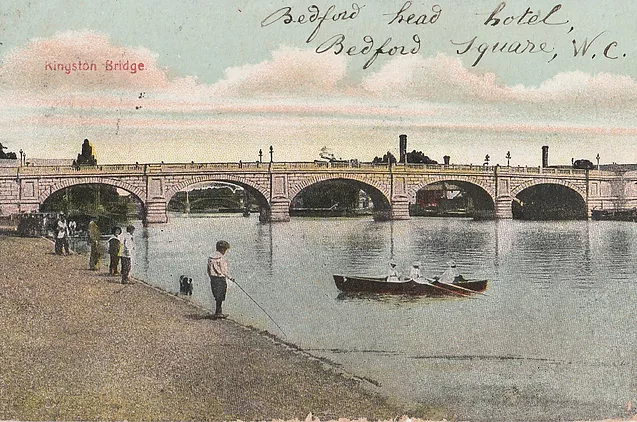
8/ Kingston Bridge, June 1870
A smartly dressed gentleman was seen walking over Kingston Bridge, when approximately half-way across, he climbed the parapet, flung his arms in the air, and shouted out “Farewell, forever!”,and plunged into the Thames.The river was dragged by police, and his corpse was discovered nearby.
9/ Kingston Bridge, June 1873 (Chancellor of the Exchequer Causes Suicide)
A man committed suicide by jumping off Kingston Bridge into the Thames, then left a suicide note blaming the Chancellor of the Exchequer for his demise. The victim was George Smith, a 55-year-old fishmonger from Caterham Valley in Kent. He left a hat and a pocketbook on the bridge, with a passing Corporal from the 7th Hussars, coming across it. The letter read:
“My dear, I hope the Lord will help you. I cannot stand it any longer. You will find my body in the Thames, Kingston. Goodbye, and God bless you all. I hope you will not ever feel as I do.” Then scribbled on the card was ” Robert Lowe and the doctor have been the cause of this. Kingston Bridge.”
The son was interviewed about the father’s suicide and he explained that his father had been knocked down by the Chancellor of the Exchequer, Robert Lowe, who was riding a bicycle. He was in the hospital for over a month and had sustained three broken ribs. The fishmonger business suffered and he thought that Mr Lowe hadn’t given him adequate compensation for the accident and he went into a depression. The doctor’s part in all this was a hefty bill for medical services, that he could not pay.
10/ Kingston Bridge Suicide, October 1897
Just after midnight, a well-dressed young woman of around twenty-years of age killed herself by jumping off Kingston Bridge and drowning herself. A policeman on his beat heard the shriek, then a splash of water. He got in a boat and went to rescue the young lass, but found her body floating on the surface. The deceased was a domestic servant who worked in Molesey, just down the river. The body had various cuts and bruises on it, from her striking one of the buttresses on the way down. (Name?)
Southwark Bridge.

11/ Southwark Bridge Road, (Box of Skulls) March 1909
While workmen were digging the foundations for an extension to the London Fire Brigade HQ in Southwark Bridge Road, they stumbled on a six-foot-long box, which contained seventeen human skulls and the skeletal remains of seventeen human beings. Police believe that they are the remains of plague victims and were dumped in mass graves, just like this one.
12/ Southwark Bridge Road, July 1896 (Another Load of Bones)
Again the story is nearly identical to the 1909 one, when workmen were excavating at number 52, Southwark Bridge Road, when they found dozens of human skulls and a ton of bones to go with them. They were discovered in a sort of pit which covered several square yards and they were unceremoniously dumped on top of each other, and at last count, there were fifty skulls all in a good condition. (Were these plague victims as well?)
13/ Southwark Bridge Suicides, May 1845
John James Gogerley, a 51-year-old, stood on Southwark Bridge and fired a pistol into his chest. A passer-by found him lying on the floor, drenched in blood and with the pistol stock still in his hands, with the barrel blown to bits. He told a night watchman named Pearce that he wanted to kill a rabid dog near his sister’s house, so he lent him the weapon. He lingered in the hospital for a few days but finally expired.
14/ November 1869
A gentleman was strolling over Southwark Bridge towards Cannon Street, holding a medicine bottle, when he stopped and asked a chestnut-seller which way St Paul’s churchyard was. She was just pointing him in the right direction, when he leapt upon the parapet, then hollered “This is the way!” and fell head-first into the icy waters of the Thames. Apparently, this was the third such suicide from Southwark Bridge in the past month.
Tower Bridge
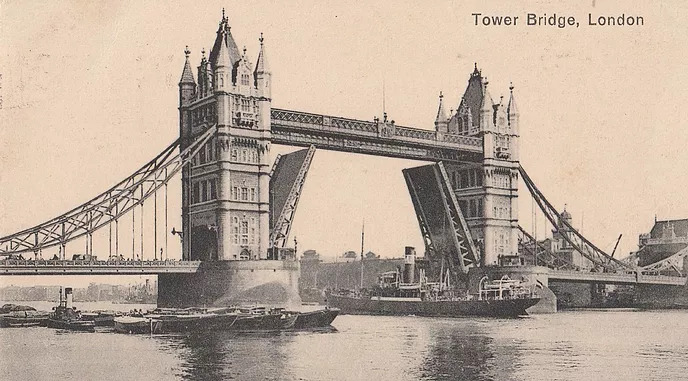
15/ Tower Bridge Corpse, November 1889
Construction was begun on Tower Bridge in 1886 and was completed in 1894, so the discovery of a female corpse under one of the arches at the approach to the new bridge, was certainly while there were bricks and mortar all over the place. A man named Tiddley saw the woman in a foetal position and told a copper. When she approached it was found that she was lifeless.
16/ Tower Bridge, November 1894 (Fatal Leap of Professional Diver)
Benjamin Fuller was a 38-year-old clerk during the day and a professional diver at the Royal Aquarium in his spare time. The Bridge having just been completed, as a sort of stunt he told his missus that he was going to jump off the Tower Bridge the next day. He performed the dive and when he came up, he turned his head, then sank. The post-mortem examination revealed that he had died from suffocation and the cause of drowning was the “concussion of the chest with the water, resulting in loss of breath”. In layman’s terms, he smacked the water like concrete causing injury to his chest and internal organs.
17/ Tower Bridge Fatality, July 1894
The construction was nearly finished and the scaffolding was beginning to come down. One labourer, 36-year-old Edward Burns from Poplar, was on top of the scaffolding when he accidentally tripped and fell straight into the Thames and sank like a stone. The police dragged the river for the body but it wasn’t recovered, so if a professional diver (above) can’t survive a fall like that then a workman definitely won’t. (Did they recover his body?)
18/ Tower Bridge Suicide Attempt, August 1895 (Did he die of his wounds?)
This chap, Thomas John Foster, only about thirty odd, had been an out-patient of Guy’s Hospital for “softening of the brain”, whatever that means. He never showed signs of any suicidal tendencies but he flung himself from one of the upper parts of Tower Bridge. He caught the side of the bridge on his way down which diverted him into the roadway, breaking an arm and his ankle. Foster, while laying in a heap and realizing he hadn’t killed himself, was approached by a policeman and thinking rather quickly for a supposed lunatic, told him to go and stop his brother from jumping off. The policeman believed his diversionary lie and while he was gone, Foster took out a razor and sliced open his throat. The policeman came back and found Foster with his fingers in the deep gash, trying to make it fatal. He was whisked off to Guy’s hospital where he was placed in a padded cell.
Westminster Bridge
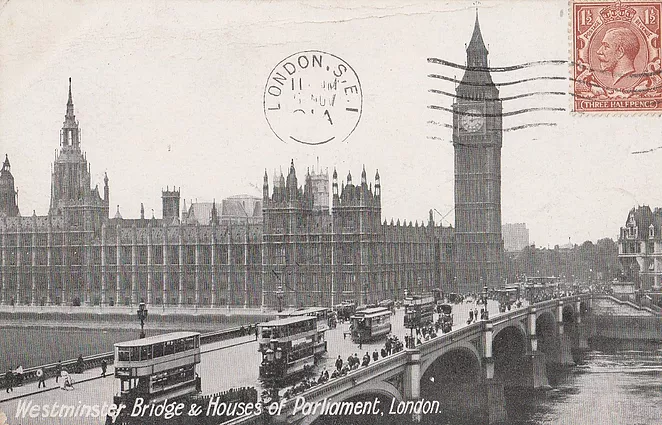
19/ Westminster Bridge March 1909 (Coded Suicide Note)
This is certainly my favourite clipping in the London Bridges section. I think that even the great fictional detective Sherlock Holmes would give himself an aneurysm trying to work out this coded acronym. It starts with the suicide of a Balham shop assistant, Florence Elkington who plummeted from Westminster Bridge to her death. A Valentine card was sent to her boyfriend and scribbled on the back was the following: “My Dear Mother- just a few lines to say that I am- G.N.L.U.B.J.A.V.T.”
The boyfriend was Joseph Gesuri, an Italian who resided in Mayfield in Sussex. He told police that he had known her for four years and even proposed to her three years ago. He went to her house at Balham on Sunday afternoon, then that night they got the train to Westminster Bridge. He gave her the Valentine back, thinking that she must be seeing another bloke behind his back. On the tram, he fell asleep, and the conductor told him that the young lady got off at Westminster Bridge and there had jumped into the river. (I thought the J.stood for Joseph and the V.was Valentine, but that was as far as I got! Just to tidy one thing up, the acronym was written on the back of the valentine handed back to her so she did this just before her suicide. I think!)
20/ Westminster Bridge, May 1902 (Watched Husband’s Suicide)
William Charles Beale, a 27-year-old fishmonger’s assistant pulled a sicky at work and went to the Epsom races instead. His employer sacked him the next day. Then one evening, while he was strolling over Westminster Bridge he suddenly had a mad moment and he gave her his watch, then mumbled “You can always get something for that”, and dived into the water.
21/ Westminster Bridge Fatality, September 1909
A painter, Henry Champion aged thirty-two, was giving Westminster Bridge a new coat of paint when the plank of wood he was standing on gave way and the poor chap was thrown into the Thames. Champion was a good swimmer but the fall had caused a spinal injury, so he couldn’t manage more than a few strokes before he vanished under the murky brown waters.
22/ Westminster Bridge Murder, August 1881
A Private in the Coldstream Guards, John Evans, was charged with the murder of a prostitute (“Unfortunates” as they were called in those days), by shoving over Westminster Bridge. A witness saw the two of them on the bridge and he seemed to help her up, then grabbed hold, then let go of her. They were slurring their words as if they were drunk. He waited a minute then walked away. Another witness said she’d seen them both arguing the toss and swearing at each other. A fellow soldier in the Grenadier Guards, said that he met Evans and he said “I and a female have had a few words; Shall I jump over, and I said “Yes”. ” The body of a female matching her description was spotted near a river steamer, but couldn’t be recovered. (Who was she?)
23/ Westminster Bridge Tragedy, July 1841 (Tragic Accident-Three Drown)
One early evening in July of 1841, a boat with people in it, capsized, when it hit the fourth starling on the Lambeth side of Westminster Bridge. Rescue operations went into full swing and four of the passengers were saved but another three were lost in the muddy waters of the Thames. Two of them were a newly married couple, who were wed the day before this awful occurrence.
24/ Westminster Bridge Suicide, February 1914
A bridge cleaner, David Edwards, was going about his business on Albert Embankment when he saw a woman sat on a bench reading a book. He thought it was strange because of the freezing cold temperatures, so he pretended to adjust a lifebelt so he could chat to her. After talking to her she seemed OK, so he left her alone. A short while later he was near Westminster Bridge when a man told him that he had just seen a woman’s face in the water. It turned out to be the female reader he had seen a while ago. The corpse was identified as Mary Ion, the widow of a captain in the Navy. Her suicide must have due to the fact that her husband was dead and she had nine children to look after, she became more and more depressed with each passing day. The lady had worked in a Birmingham hotel but left on the 14th January and stayed with her husband. Then she had left him to go back to Birmingham and work and he had died in the meantime. Mary Ion never saw her husband again. It was thought that she was in London looking for a job to support the kids.
London Bridge
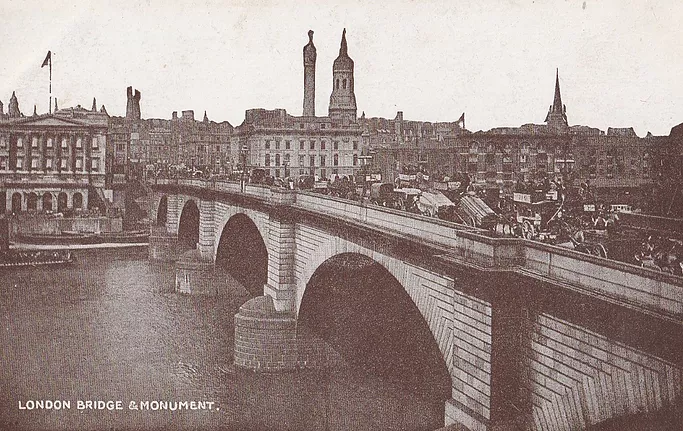
25/ London Bridge, January 1862 (Omnibus Suicide)
Mr Herring, the owner of an omnibus company in Lewisham, had been running his vehicles from there into the City on a daily basis, then returning to Lewisham. One night the omnibus was on its usual route, when the conductor, Mr Herring junior, the boss’s son, jumped off the “monkey board” and while in motion, he ran through the crowds and straight onto the steps of a recess and dived into the Thames. Throngs of people gathered around and a drag of the river never caught the body. Witnesses said on the way down he appeared to strike the brickwork and masonry very heavily, so could have been dead before he went into the water.
26/ London Bridge Infanticide, December 1875
A jury decided that Jan Hase, a German, was guilty of the wilful murder of an infant who died from exposure after being abandoned by him on London Bridge. When arrested, he readily admitted that the child belonged to his sister and that she had come from Holland to be confined. He couldn’t find anyone to take care of the infant, so he left it on London Bridge hoping that someone would care for it or take it to a workhouse.
27/ London Bridge Suicides, April 1883
While a P.C was on his beat one morning, over London Bridge, a man described by the officer as mid-thirties and wearing the attire of a butcher, came rushing towards him. He took off the apron and gave it to the officer, who was confused by the sudden actions and then climbed onto the edge of the bridge, hollered “Goodbye, I’m off!”, then dived in. The policeman tried to grab hold of him but he was just too late and he entered the waters and promptly sank like a boulder. Police dragged this section of the Thames but came up with no body.
28/ March 1896
A woman who had been sat on the bench near London Bridge for hours on end, suddenly rose to her feet, mounted the parapet and screamed “Prevent me if you can; I’ll do it while I’ve got the chance”, then plummeted off the edge, hitting (as you can see in the postcard above) one of buttresses on the way. She must have been concussed as she hit the water and she soon sank. Her body was not found but she was described as five feet two inches tall, 35-ish, fair-haired, with a black straw hat, jacket and black skirt on.
29/ London Bridge Boat Accident, March 1885
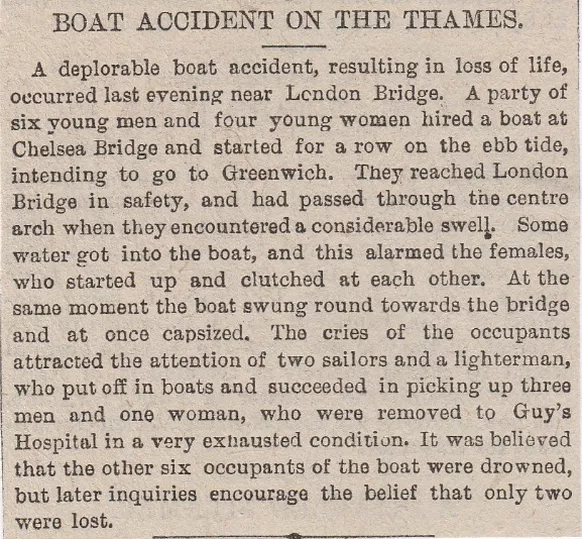
30/ London Bridge, May 26th, 1872 (Another Boating Accident)
Mr Jewson, foreman of Phillips and Graves, lightermen, decided to go out on the Thames with his family and friends, about a dozen in total, in a pleasure boat to Kew. They got as far as going under the arches of London Bridge when a steamer swung around and her keel smacked into the pleasure boat and tipped it over. Everyone was thrown into the Thames and nine were fortunately rescued. The dead were three young lads; Thomas Llewellyn aged eighteen, Thomas Morgan aged fourteen and fifteen-year-old Thomas Jewson.
31/ London Bridge Suicide, December 1886
A woman dressed all in black climbed the seat of one of the recesses on London Bridge and plunged into the water. The bridge was chock-a-block with pedestrians and horses and carriages travelling along and one brave soul tried to grasp hold of the female suicider. She was found by a pair of boatmen down the river and taken to the hospital. The patient was unconscious and had a huge gas under her chin and despite every effort to save her, she expired soon afterwards. The post-mortem showed that she had both thighs broken and her lower jaw was shattered, due to the impact when she hit the buttress. Age is thought to be around the mid to late-twenties.
32/ London Bridge, December 1919 (Sweetheart Suicide)
Nineteen-year-old Annie Seabrook from Smithfield, jumped off London Bridge whilst on a walk with her sweetheart. Albert Woods, piermaster, said he heard a shout and ran down to the foreshore to see a soldier who said that his girlfriend had just jumped into the Thames. The boyfriend, Frank Vail, a gunner in the Tank Corps, said that he had been going out with her for five years and they’d gone for a walk over the bridge. They parted for a minute, then she shouted-“Goodbye, mate!” and dived in. He said there hadn’t been a quarrel of any kind and he was at a loss as to why she killed herself.
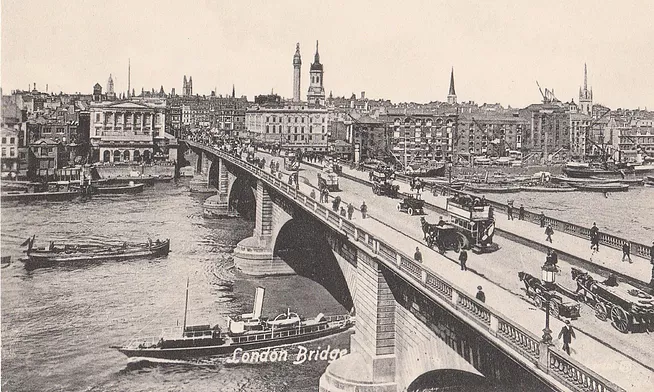
33/ Victoria Bridge Suicide, Chelsea, May 1885
A man of dapper appearance was seen to jump from the Victoria Bridge at Chelsea. A witness described that on his descent, he clattered into the buttress and was saved from entering the Thames. Unfortunately, the striking of the masonry on the way over, finished him off as he died at the hospital, shortly after being admitted. He is approximately forty years of age, five feet seven inches, dark-haired, moustache and beard with grey eyes. A couple of letters were in his pocket, addressed to “Mr M.Archer, 44, Chatham Street, Battersea” and another to “T.P.Gilfoyle, c/o Mr Green, 76, Great Portland Street”
34/ Wandsworth Bridge Boating Fatality, September 1902
A sad boating accident occurred near Wandsworth Bridge one afternoon. Miss Frances Langley and Arthur Bidgood, residing in Clapham, an engaged couple who were due to be married next week went for a boat trip on the river. When they got to Wandsworth Bridge he stood up to take his jacket off and the boat started to wobble, then tipped over. The pair were precipitated into the river and Miss Langley was eventually rescued, but Mr Bidgood was carried off with the strong current.
35/ Vauxhall Bridge Corpse, August 1910
The body of William James Brody aged forty-two, of Rowton House in Newington Butts was found floating in the Thames. Walter Pickett, a swimming instructor known as the “Professor” was on the banks of the Thames, waiting to see a female competitor in the swimming race on the Thames. He noticed a dark object and decided to time it, with it travelling 25 yards in nearly two and half minutes. When it got close he saw that it was a dead body. He went and got the nearest policeman who managed to get the River Police to recover it. He was found to have died from drowning. No surprise there then!
Rowton House, similar to where Brody would have lived.

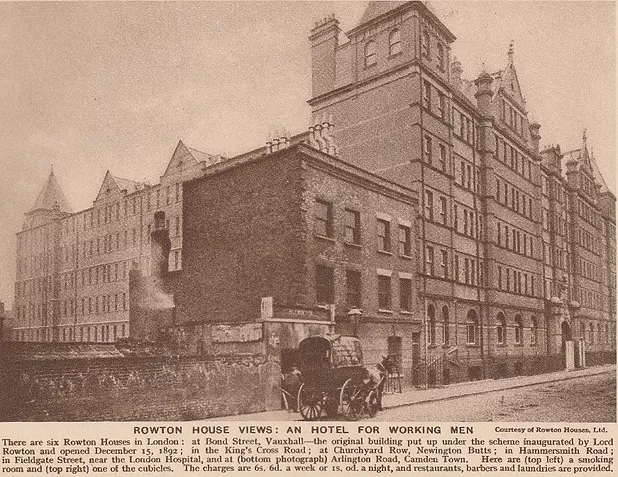
36/ Hammersmith Bridge, June 1899 (Bridegroom Drowned)
The death of a bridegroom occurred near Hammersmith Bridge, through a lover’s tiff. George Lewis aged twenty-four; William Harris aged twenty and Miss Amy Green aged twenty-one, all from Fulham, went for as row on the Thames. They approached Hammersmith Bridge, when the loving couple Lewis and Green, suddenly started an argument. He rose up in anger, the boat tipped up and all three ended up in the water. Harris was a good swimmer and managed to hold onto Miss Green until help arrived. Lewis couldn’t swim very well and he drowned. Miss Green and Mr Lewis were meant to have tied the knot today.
37/ Hammersmith Bridge, September 1899 (Servants Suicide)
Julia Curran was a domestic servant living at Escourt Road, Fulham, until her lifeless corpse was found floating in the river near to Hammersmith Bridge. Her sister, Mrs Villiers, said she worried about their mothers drinking seeming to get of hand. Julia came down to London from Maidenhead where she worked, to spend a few days with her sister. Apparently, Julia and the mother had not spoken for ages due to her drinking and her incessant untruths told about her. Julia chipped in to take care of the mother, but as her mother kept slagging her off, she cut the amount she used to send. Julia had gone to Putney Bridge about a year and a half ago in an attempt at suicide because of her mother’s conduct, but returned to see her sister to say “Goodbye”. An argument broke out between the two of them a couple of days ago and Julia again threatened suicide at Putney Bridge, but this carried it out. Her own mother caused her sad demise.
38/ Putney Bridge Soldier Suicide, May 1915
Putney Bridge is famous for being the place where the serial killer, John Christie, was arrested in March 1953. He murdered eight women and his wife, at the infamous, 10, Rillington Place in Notting Hill.This other story is about a private who killed himself, while on duty at Putney Bridge. Thomas Joshua Flatt, a private in the 24th County of London Regiment shot himself with his own rifle. He sent a note to Sergeant Rusling, saying;”I leave all my things to Eva Churchman- Tom Platt”. Nobody knew who Eva Churchman was and had never met any such person.
39/ Putney Bridge Deaths, June 1903
George Cobb, a sailor, was crossing Putney Bridge when he heard someone shout out “A man in the river!”. Cobb dived in after him and although the attempted suicide was fifty yards further upstream Cobb swam after him, watched by hundreds on the bridge and banks. He grabbed hold of the suicide but was dragged under the water by him. An act of bravery and a good deed has cost this sailor his life.The bodies of the two men washed up on the riverside at Wandsworth Pier. The suicide was identified as a Fulham labourer, George Cribb.
40/ Hungerford Bridge Drownings, April 1898
Two men drowned in a tragic accident on the Thames at Hungerford Bridge. Their rowing boat was going around some barges when a collier “Alert”, didn’t live up to her name and split the boat in two. There were eight in the boat and six were rescued, with the other two men vanishing underwater.
41/ Hungerford Bridge June 1845
The very first suicide from Hungerford Bridge, occurred at three a.m. one morning when a well-dressed gentleman jumped off the centre of the bridge and was drowned.
42/ Waterloo Bridge Famous for the “Poisoned Umbrella” shooting of Georgi Markov, by the Bulgarian DS on the 7th of September,1978. Killed by the pellet containing ricin. Nicknamed the “Bridge Sighs” due to the number of suicides on it.
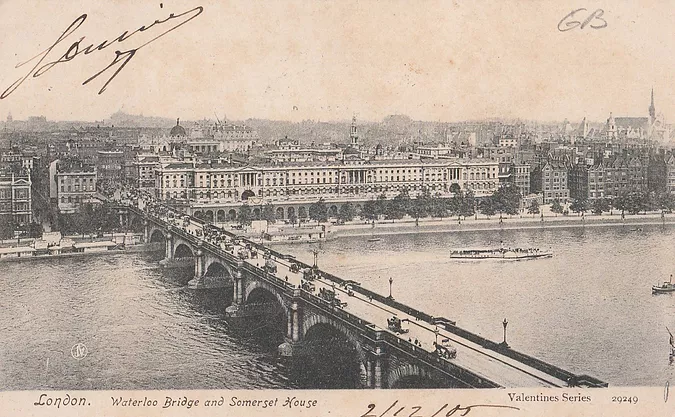
43/ Waterloo Bridge, September 1901 (Sad tale-straight to the point)
Allegedly this is the shortest explanation of committing suicide ever recorded. The man’s name was Jeffries and he threw himself off Waterloo Bridge.and left a note in his pocket. It simply read: “Drunken wife- G.Jeffries.”
44/ Waterloo Bridge Suicide Note, September 1910
Another melancholy story from Waterloo Bridge. Mrs Charlotte Read aged sixty-nine felt that she was a burden to her son and also didn’t want to leave her house in Clapham where she had many happy memories, but mainly because her husband died in there a couple of years ago. She went off to the bridge and jumped into the River Thames, but left this suicide note explaining just how she felt about the situation.
“My Dear son Jack- I am going to Waterloo Bridge. I am out of my mind to do it, but I cannot leave the house. I am tired of my illness, and will go to your father and rest.”
45/ Waterloo Bridge, May 1893 (Died for a Bet)
John Steele Jenkins aged thirty-one, who worked as a printers labourer, made a bet that he could dive off Waterloo Bridge and into the Thames for a bet. On his leap off the bridge, he struck his head and never rose to the surface. His body was recovered after several days and was deemed to be “Accidental Death”.
46/ Waterloo Bridge Suicide, July 1902
While crossing Waterloo Bridge, Helen Rooney aged twenty-one from Oakley Street, Lambeth, climbed up onto the parapet and jumped into the water and was drowned. Her friend, Ellen Chapman, who was present when she committed suicide said that Helen was depressed because she was unemployed. She would often blurt out “I am tired of life. I’m tired of it all, and shall take my life at some time or other”.
47/ Waterloo Bridge, September 1894 (Fatal Accident)
A van was coming from the Strand end of the bridge, drawn by a couple of horses, when a sudden noise scared the beasts and they bolted. Several people tried to stop them and the driver tried to halt them by tugging on the reins, but he fell off. The heavy cart went straight over his head and chest. He was taken to the hospital but died on his way there.
48/ Waterloo Bridge Suicide, May 1855
Harriet Lowe aged twenty-nine, was co-habiting with a waiter from the Printers Arms, Strand, by the name of Drew. She went to the pub and had a quick drink, then left to go to a pawnbroker’s in Whitechapel. She returned for another shot of gin and then started an argument, in which she accused him of seeing another woman. Lowe stormed out of the pub and was next seen on Waterloo Bridge by the lighterman, to leap off the balustrades and into the Thames. The verdict was one of “felo de se”, or suicide.
49/ Waterloo Bridge Mystery, June 1859
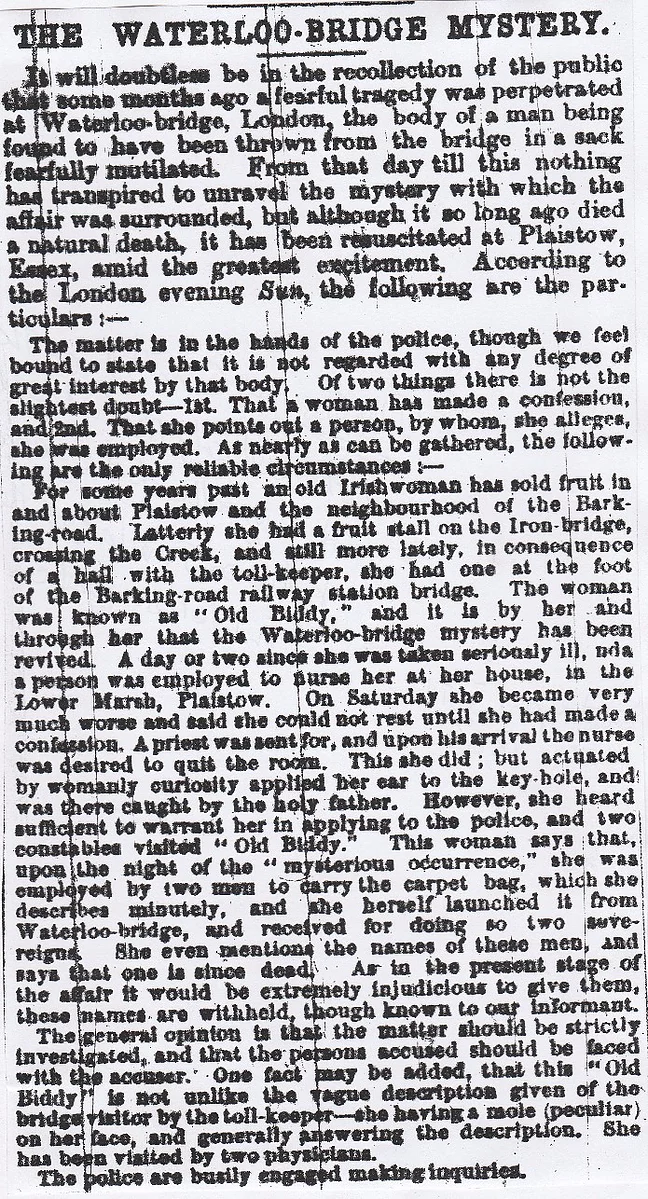
Waterloo Bridge Mystery, June 1859
The Irishwoman known as “Old Biddy” has been taken from her lodgings in Plaistow to the Essex County Lunatic Asylum. Her version of events, that she took the bag with the remains in them to Waterloo Bridge and was paid a couple of sovereigns by two fella’s, doesn’t tally with what police think happened.
50/ Waterloo Bridge Premature Suicide, April 1899
Here’s a gloomy tale with the moral of the story being,” just hang on a bit longer….you never know!”. That’s my words of wisdom out of the way, on with the story. Ellen Harding of 104, Walworth Road, jumped off Waterloo Bridge and into the Thames due to having no money, and no work. Ellen was getting on a bit and was a widow, who had been unemployed for quite some time and was now getting desperately ill. She had applied for a job as a house-keeper but had got no reply. The next time somebody saw her, it was watching her dive off Waterloo Bridge to drown herself. Her body was fished out, covered in cuts and lacerations which were sustained when she hit the masonry on the way down. Here’s where my moral kicks in and it was the day after her suicide, a letter came to the door from the firm which she had applied, congratulating her on getting the job and when could she start.
51/ Waterloo Bridge March 1862
A well-dressed gentleman was seen by a gatekeeper at Waterloo Bridge, to be holding a letter with a large amount of writing on it, then casually walked over the bridge, and climbed the parapet, and then plummeted into the river.A group of three people shouted at him to stop, but it fell on deaf ears.The man left a cloth cap, with the letter inside, and it went:-
“To the Governor of Nuget (Newgate)
Dear Sir- I beg of you to read my reched (wretched) life which I ave this nite Friday, put an end to. Peraps your onner (Honour) will remember the Road Murder which took place about thirteen months back. So I rite to you Sir to informe you that I was the one wo don this awful murder which I hope to be forgiven. About four years ago I took to gambling and got in det and ad to go away to the country, where I done the fearful deed and then cum to London wich (which) I ave lived in misery. I ave nothing to say for wot I don this awful deed for I was quite a stranger to the ole family. I ave nothing further to say as my feelings will not allow me to say any moor, only that the way I have put an end to my life is I have fling myself off Waterloo Bridge.
Yours respectfully- Wil Moor.
I have no friends. But an uncal (uncle) in France, wo this I would fane ceap (keep) from him.”
On the outside of the letter, was the following sentence:-
“To the Governor of Nuget- Profe(proof) of the Road murder. To be given to a Pleace Man (Policeman). I have thrown myself off the bridge.”
Police are ignoring this as a work of fiction and of a lunatic. It was found to be the work of a Penny-a-liner, which is a person who got paid per line to contribute to newspapers. So it was a fake! I thought it was odd that he could spell “respectfully”, and not “which” or keep”.
Thames Embankment with Waterloo Bridge in the background
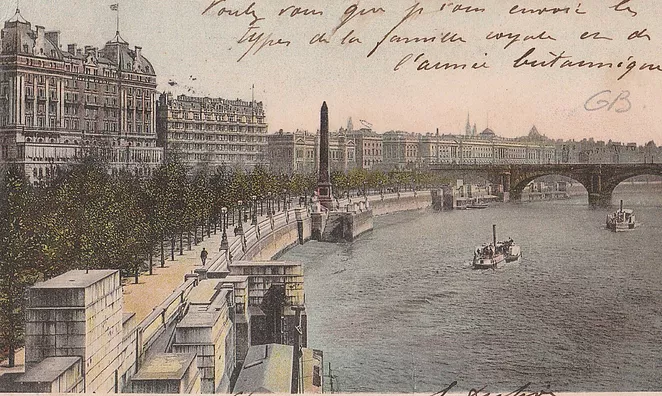
52/ Thames Embankment/Waterloo Bridge, November 1905 (Mysterious Death)
The corpse of a twenty-year-old John Doe was discovered on the steps of the Thames Embankment (above), under Waterloo Bridge (in the background). A tramp found the body with its head below the water and stone-cold dead. When the police took the body to the mortuary they turned out the pockets and found nothing but a….toothpick! He was dressed smartly enough in a tweed suit, with the bullet wound to the temple was the cause of death, but they found no gun or ammunition near the body. The condition of the clothes suggests that he’d been in the water at some stage and the autopsy showed that he had only been dead around two hours before they found him. Later on, it was confirmed that the bullet had not killed him outright, but the shock from the concussion caused by the bullet and from drowning. A Sheffield address was found on his shirt but no other clues were found.
53/ Waterloo Bridge, September 1872 (Really Sad Story!)
This is one of the deaths in the website that I genuinely want to find, then go and put some flowers on her grave. The other two, were a girl in Lancashire who went blind at thirteen, then lost her job and eyesight, so then committed suicide; the next was a young lass in Anerley (Bromley) who gave birth in a shed and died; then there is this one. An American woman of only twenty years of age by the name of Alice Blanche Oswald, who killed herself by jumping off Waterloo Bridge. Her landlady, Mrs Eliza Cooke of 178, High Street, Shadwell, identified the body as that of her lodger and told her that she had come from The United States with a lady who had four servants but got rid of two as soon as she arrived in England. She was then fired and had come to London to see the American Consul, in a bid to get help to return to America. A letter arrived at the lodgings and Miss Oswald seemed distressed when she read the contents, so she got dressed and vanished thereafter. The letter she left behind read:
“London, September 3rd, 1872. 178, High Street, Shadwell
The crime I am about to commit and what I must suffer hereafter, is nothing to compare to my present misery. Alone in London, not a penny or friend to advise or lend a helping hand, tired and weary with looking for something to do, failing in every way, foot-sore and heart-weary, I prefer death to the dawning of another wretched morning. I have only been in Britain nine weeks. I came as a nursery governess with a lady from America to Wick, in Scotland, where she discharged me, refusing to pay my passage back, and giving me only my wages, of £3 10 shillings. After my expenses to London, I found myself in this great city, with five shillings. What was I to do? I sold my watch. The paltry sum I obtained soon went in paying for my board and lodging, and in looking for a situation. Now I am destitute. Every day is a misery to me. “No friend” “No hope” “No money”. What is left? Oh, God of heaven, have mercy on a poor, helpless sinner. Thou knowest how I have striven against this, but fate is against me. I cannot tread the path of sin, for my dead mother will be watching me. “Fatherless, Motherless, home, I have none.” “Oh for the rarity of Christian charity” I am not mad. For days I have foreseen that this would be the end. May all who hear of my death forgive me; and may God Almighty do so, before whose bar I must soon appear! Farewell to all- to this most beautiful and yet to me, most wretched world. Alice Blanche Oswald. I am 20 years of age the 14th of this month.
The jury returned a verdict of “Suicide whilst in a state of temporary insanity”. She wasn’t mad, just desperate and alone.
The funeral of Alice Blanche Oswald at Woking Cemetery (now Brookwood Cemetery, largest in Western Europe, with a quarter of a million bodies, lying in 400 acres.) September 1872.
The Reverend Simpson of St Clement Danes arranged the funeral of Alice, and people of the parish chipped in to pay for it. She was interred at Woking Cemetery (Brookwood), with a large crowd of mourners and a group of American ladies throwing flowers on her coffin. The inscription read “Alice Blanche Oswald, died September 5th, 1872, aged 20 years.”. Sadly in the following month after her death, Waterloo Bridge saw eight more women kill themselves from it.
Waterloo Bridge, with Somerset House in the background.
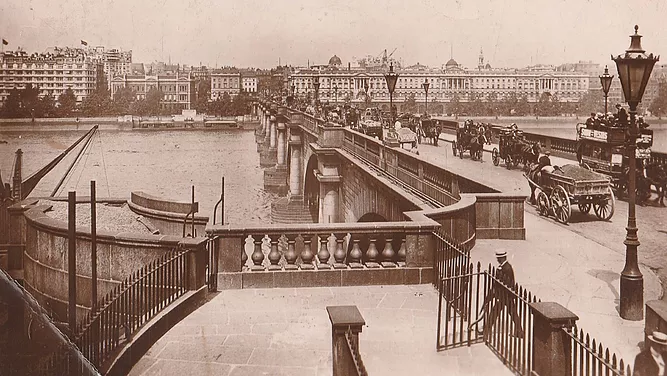
54/ Waterloo Bridge Suicide, August 1908 (Jane Wallace 1)
Two sisters from London who were grief-stricken at the loss of their mother, both killed themselves by drowning in the Thames. The two women, Jane and Elizabeth Wallace lived in Bermondsey with their blind mother, and when she passed away the two were inconsolable. They simply vanished one day and were not seen again, until their bodies were fished out of the river. Jane’s corpse was seen floating at Fenning’s Wharf in Bermondsey and Elizabeth’s was found near Waterloo Bridge.
55/ Waterloo Bridge Suicide, March 1909 (Jane Wallace 2)
If you’re going to be picky then I suppose the Jane Wallace from the story above was found in Bermondsey, but the fact that two women of the same name, were to commit suicide eight months apart within a few miles of each other is a coincidence and a half. This Jane Wallace was a twenty-six-year-old Glasgow waitress who had inherited a large amount of money and moved to London. She went with Mabel Bennart to see the Exhibition, but she left her because she was plastered. A P.C. saw her at Waterloo Bridge and she was climbing the parapet, looking like she was going to jump off, when he grabbed hold of her but she fought him off and fell into the water and drowned.
56/ Kew Bridge Murder/Suicide, October 1882
The bodies of a mother and child were found floating together under Kew Bridge. It is a case of Murder/Suicide, as the mother, twenty-nine-year-old Ellen Deane had an argument with her husband and then when he went to work, she gathered up her three-year-old daughter and walked out the house at New North Road, Brentford. The pair were tied together with a handkerchief by the mother and is thought to have committed suicide near Kew Bridge.
57/ Kew Bridge Suicide, August 1897
Charles West lived at the Hollows, Brentford, with his wife and family, but he had been suffering from an illness and was bordering on being a manic-depressive. He never said that he wanted to end it all, but early one morning he ran out of the house in his night-shirt straight onto the bridge at Kew and leapt into the water. Passers-by tried to halt his progress, but he evaded them all. The probable cause of his suicide was the fact that the doctor had informed him that his illness would be permanent and the chance of recovering was minimal. Cheers Doctor!
Richmond Bridge
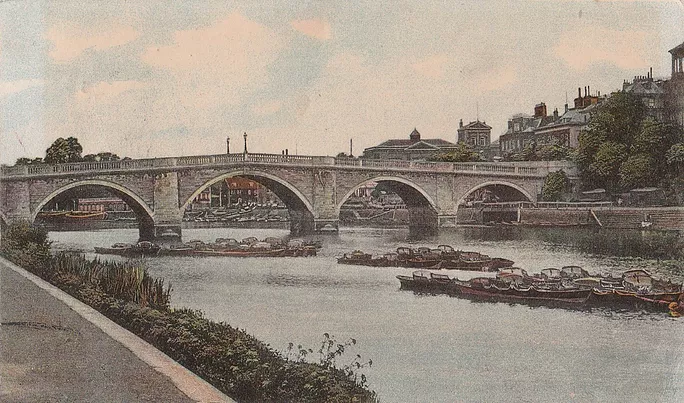
58/ Richmond Bridge, (Body Found) December 1886
After reading what sounded like a description of her sister’s items, Rose Leahart of 175, Ladbroke Grove Road, Notting Hill, went to Richmond Police Station and positively identified them as her sister’s. The items were a hat, black cloak, handbag, purse with some change in it etc. Her sister was thirty-three year old Norma Thopla Leahart who lived with her sister in Notting Hill, had gone to Kings College Hospital several days ago but hadn’t returned. She was described as dark-haired short, stout, wearing a Merino dress with buttoned-up boots. One strange piece of the jigsaw, was that when the clothes were found they were soaking wet but were beyond the high water mark. How did they get wet?
59/ Richmond Bridge, (Vanished without a Trace) December 1905
Miss Louise Ward Telfair of Chepstow Villas in Bayswater, rather mysteriously vanished without a trace. Her sister was asked to identify some items that had been discovered near Richmond Bridge which were thought to belong to her missing sister. The items were a pair of black gloves, Japanese silk purse (containing a house key), a photo of her niece, crochet purse, a few bills, umbrella, and three brooches. They were found by a waterman, John Bridger and he went with the sister to show her where he found them, by the steps of the boathouse adjoining Richmond Bridge. Footprints were seen in the mud and there were another two prints stood by the foreshore, but none returning back. These items were found a week ago and then handed in, but it was taken seriously by the police and Bridger had to go in a second time and tell them that he thought they were the missing girl’s things. Her body wasn’t found by the dragging of the river. (Was she ever found ?)
60/ Battersea Bridge Suicide, January 1879
The body of James Halstead was discovered floating in the river near Battersea Bridge. A post-mortem showed that he had been in the water for a few days and he was worried that his wife and family would go without as he had joined the mason’s strike. Another reason to “hang in there” was the fact, that just a day or two after the corpse was found, an aunt had left him a £1000 in her will.
61/ Battersea Bridge, May 1846 (Mother Throws Kids in the Thames)
A smart young woman walked up to Battersea Bridge on a Saturday afternoon, with her children accompanying her, a seven-year-old boy, a four-year-old girl and a ten-month-old girl, which she cradled in her arms. In the centre of the bridge, she coolly picked them up, one by one, and tossed them over the edge. All three went over and she was just about to jump herself when she was grabbed hold of by passers-by and held until a policeman could take her to the station. She was identified as Eliza Clark aged twenty-four, living in Cumberland Street, Marlborough Road, Chelsea. Two of the children drowned and the four-year-old girl was rescued. A huge crowd was waiting outside the police station in Milman’s Row to see what type of woman would throw her children in a river. It is entirely possible that she suffered a mental breakdown.
62/ Battersea Bridge, July 1869 (Death on a Wedding Day)
A wedding took place at St Mark’s Church, Kennington Park (Near the Oval Tube Station- great cafe there!) on a Saturday morning and the wedding party went for a boat trip on the Thames. They set off from Vauxhall Bridge and headed towards Putney, but when they got to Battersea Bridge something caused the vessel to capsize. Everyone was thrown into the Thames and luckily everyone was dragged out, bar one gentleman. He was Dudley George Fleck, an author living at 105, Brook Street, Kennington Road, and his body was not found.
63/ Battersea Bridge, (Two Drowned) June 1873
Two lives were lost when three lads named Thomas Pearson, Alfred Chatwood, and Henry Lucas were on a jaunt up the river. They approached Battersea Bridge when it tipped over and they all fell into the drink. A brave man who was just ambling by jumped in and managed to grab hold of young Pearson. The other two sank without a trace and their bodies weren’t found.
64/ Battersea Bridge Suicide, January 1910
Jane Ann Smith was a married lady residing in Staine Road, Twickenham, and who was found dead in the Thames near Battersea Bridge. The husband explained that they lost their twenty-seven-year-old son who died in a sanatorium in Bedfordshire several months ago. That was the straw that broke the camel’s back and from then on, she seemed to go downhill and became more and more despondent. However, on Christmas Eve, she went out shopping, paid the bills, then simply vanished. All evidence points towards a suicide, but the only verdict they could arrive at was one of “Found Drowned”.
65/ Battersea Bridge, July 1868 (Newly Married Couple Drown)
Another instance of a newly-wed couple going for a trip on the Thames, then ending up corpses within a few minutes. John Betsworth from Hendon and Sarah Chads were married at Camberwell Church. The sister of the bride, Ann Chads and a young chap named Alfred Thompson, were present as witnesses. A pleasure boat was hired afterwards and they set off from Chelsea. The parents of John Betsworth didn’t bother going on the trip and stayed on dry land. The other four got in and started up the river, with Thompson the main rower. They were nearing Battersea Church and going past the barges when they hit one of them and they overturned, sending all of them into the water. Thompson held onto the boat till help arrived but the other three drowned. The police dragged the area for the bodies but they were unsuccessful. The parents of John waited and waited by the riverside for any sign of their son. The young couple weren’t even in their twenties yet.
Lambeth Bridge
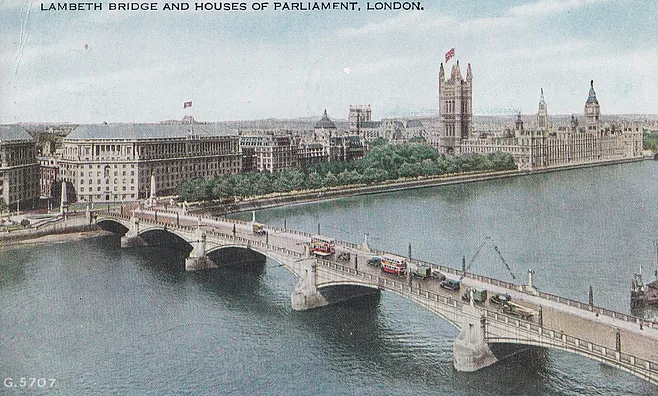
66/ Lambeth Bridge Drownings, July 1914
The body of Sir Denis Anson, Bart. was found at Lambeth Bridge on Friday night. The body was lodged underneath a raft. The story goes:- On a midnight trip on the Thames around twenty persons went from Westminster to Hampton Court, Sir Denis was a passenger and he bragged that he was going for a midnight swim and dived in. He was seen to be struggling and William Mitchell, a bandsman, jumped in to save him. They were both drowned. Mitchell was found under Battersea Bridge.
67/ Lambeth Bridge Child Murder, September 1889
Jane Noble was nineteen and married and now she was up in court on a charge of wilfully murdering her own child, who was only eight-months-old, by throwing it off Lambeth Bridge. The child was unwell and her husband, James Noble, had just walked out on her, Jane all of a sudden lost the plot. She left the house at 13, Burdett Buildings, Westminster Bridge Road and took little Matilda and threw her off the bridge.
68/ Lambeth Bridge, April 1894 (Mysterious Suicide Note)
James Keating was a labourer at a local potter’s and decided to kill himself by jumping off Lambeth Bridge. He was an Army man and had served in India and when he returned he got the job at the pottery. His two sisters hadn’t seen or heard from him in years but he left them a rather strange suicide note, which read:
“My Dear sisters, Kate and Maria- By the time this reaches you- if it ever does- I shall be no more. I have not acted as a brother ought. Owing to the company, I have neglected family matters. If either of my sister’s should see this, I don’t want them to trouble me any more; and I want them to understand that if I had fallen across my elder sister, Katie, I should have killed her”
When questioned about the meaning of the letter neither sister could determine what on earth he was on about.
69/ Lambeth Bridge Accident, September 1862
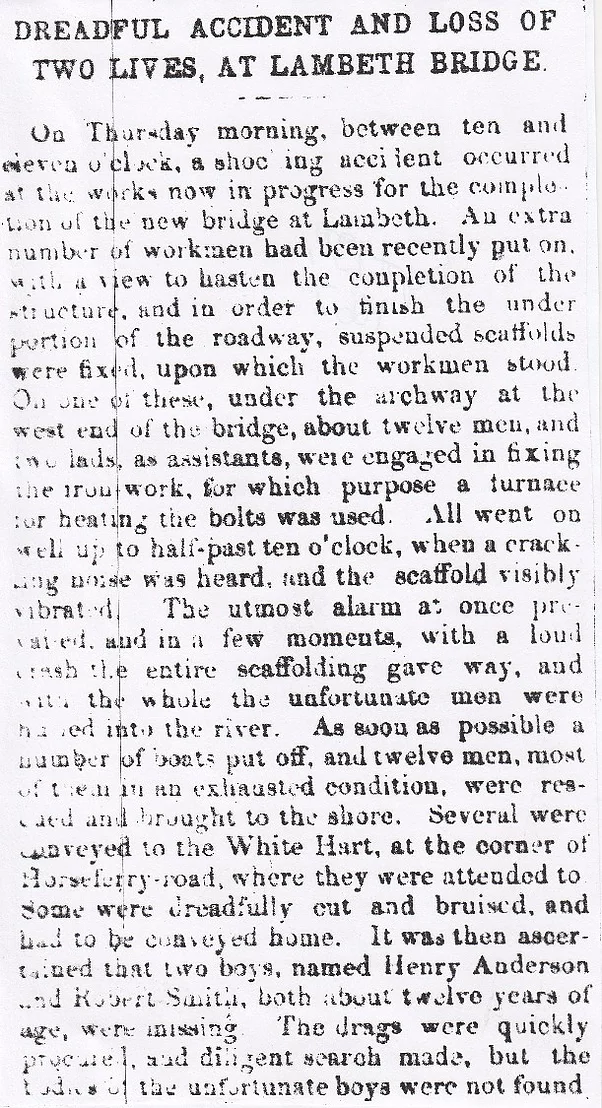
70/ Lambeth Bridge Suicide, July 1909
An unemployed shoemaker by the name of Frederick Fisk aged forty-five and living in Lupus Street, Pimlico, jumped off Lambeth Bridge and drowned, all because of him not being able to keep his family and not getting any work. He hadn’t had a job in three years and he was suffering from long-term depression, but they never applied for any relief, so it was as bad as it gets. His wife found an envelope on the bed, and it read:
“Goodbye forever. You will be better off without me. I am off to Lambeth Bridge. You will find my boots if you ask a policeman at Lambeth Bridge. Frederick Fisk”. His coat was also found on Lambeth Bridge with a sheet of paper next to it with “He who dies pays all debts”, written on it.
